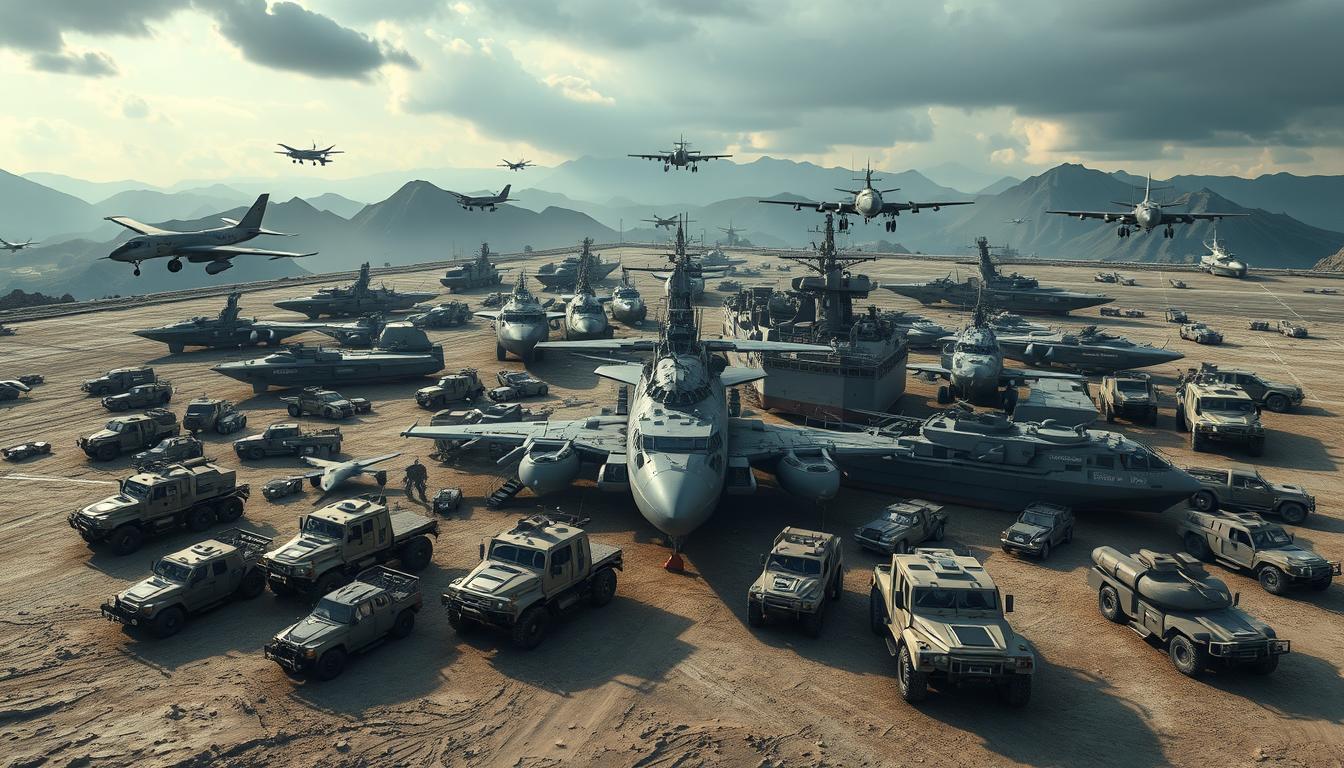Vision 2030 has become the cornerstone of a bold initiative reshaping the Middle East’s defense landscape. With nearly $70 billion allocated to military industries in 2023, this effort aims to reduce dependence on foreign arms suppliers while fostering domestic production capabilities. The question isn’t just about ambition—it’s about execution in a sector dominated by global giants.
Central to this transformation are organizations like SAMI and GAMI, which showcased advanced systems at the World Defense Show 2024. Their work highlights the dual challenge of acquiring cutting-edge technology and scaling local equipment manufacturing. This shift isn’t isolated—it reflects broader trends in the global defense industry, where economic security increasingly ties to industrial independence.
The push aligns with modernization goals across critical infrastructure and technology sectors. By prioritizing partnerships with international companies, the strategy balances immediate security needs with long-term industrial growth. However, the real test lies in sustaining momentum while competing in a $2.1 trillion global arms market.
Key Takeaways
- Vision 2030 drives a $70 billion investment to boost domestic defense production capabilities
- SAMI and GAMI lead efforts to develop advanced military systems and reduce import reliance
- Technology transfer partnerships accelerate modernization of defense infrastructure
- Regional security demands influence industrial priorities in the Middle East
- Economic diversification remains central to long-term defense sector growth
Introduction to Saudi Military Industrial Trends
The roots of Saudi Arabia’s defense sector trace back to mid-20th century industrial foundations. Early efforts focused on basic ammunition production, with the first government-operated facility launching in 1949. These initiatives laid the groundwork for today’s advanced systems.
Historical Context and Early Developments
By the 1950s, partnerships with foreign companies like BAE Systems began modernizing production capabilities. The kingdom’s first artillery shells rolled off assembly lines in 1965, marking a critical milestone. Over subsequent decades, 12 state-owned factories emerged, specializing in armored vehicles and small arms.
“Industrial independence became inseparable from national security after regional conflicts in the 1980s.”
| Era | Focus Area | Key Initiative |
|---|---|---|
| 1950s-2000s | Basic arms production | Joint ventures with European firms |
| 2016-Present | Advanced systems development | Vision 2030 technology transfers |
Vision 2030 and Strategic Diversification
The 2016 economic plan revolutionized priorities, targeting 50% localization in defense spending by 2030. Investments surged into drone technology and cybersecurity, reducing reliance on imported equipment. Government entities like the General Authority Military Industries now oversee 40+ modernization projects.
Recent partnerships with Turkish and South African firms demonstrate shifting trade patterns. These collaborations aim to position the kingdom among the top 25 arms exporters within a decade, challenging traditional suppliers.
Saudi strategies for building local weapons manufacturing facilities
The push for self-reliance in defense manufacturing marks a transformative phase in the nation’s economic blueprint. Recent initiatives focus on converting foreign partnerships into domestic capabilities while addressing systemic challenges in technology absorption.
Domestic Production Initiatives and Challenges
Efforts to develop indigenous systems face hurdles like restricted access to advanced components. While joint ventures with firms like Navantia enable warship assembly, full production autonomy remains elusive. The National Academy of Military Industries trains specialists to bridge skill gaps in aerospace and cybersecurity sectors.
Historical dependence on imported arms complicates supply chain localization. Foreign partners often limit critical technology transfer to protect intellectual property. Over 60% of defense equipment still originates from international suppliers despite recent progress.
The Role of SAMI and GAMI in Modernization
Since its 2017 launch, SAMI has secured 14 partnerships with global defense companies. Its collaboration with Baykar aims to localize 50% of drone components by 2026. GAMI oversees quality standards across 42 production sites, ensuring compliance with NATO specifications.
| Initiative | Progress | Target Year |
|---|---|---|
| Combat vehicle production | 35% localized | 2025 |
| Radar systems development | Testing phase | 2027 |
| Avionics training programs | 1,200 graduates | 2024 |
These agencies prioritize dual-use technologies that serve civilian and military markets. Their work underscores the kingdom’s shift from buyer to co-developer in global defense projects.
Local Manufacturing Capabilities and Technological Partnerships
Strategic alliances with global defense leaders are accelerating technological advancements in the region’s military sector. Saudi Arabia now operates 17 specialized production complexes producing armored vehicles, surveillance drones, and missile guidance systems. These facilities combine imported components with locally engineered solutions to meet NATO-standard requirements.

Foreign Collaboration and Joint Ventures
Lockheed Martin’s $1.2 billion agreement with Saudi Arabian Military Industries (SAMI) exemplifies transformative partnerships. The deal enables localized assembly of THAAD missile defense systems while transferring avionics expertise to regional engineers. Similarly, Baykar’s drone manufacturing plant near Riyadh achieved 40% local content within 18 months of operation.
Recent collaborations focus on dual-use technologies. Airbus Helicopters partnered with local firms to establish rotorcraft maintenance centers, while South Korea’s LIG Nex1 supports radar development initiatives. These ventures address critical gaps in:
| Partner | Focus Area | Local Impact |
|---|---|---|
| Lockheed Martin | Missile systems | 55% component localization |
| Airbus Helicopters | Aviation maintenance | 300 technicians trained annually |
| Baykar | Drone manufacturing | 2,000 units/year capacity |
Such cooperation enables gradual shifts from assembly to full-cycle production. SAMI reports a 200% increase in locally developed electronic warfare systems since 2021, signaling progress toward defense industrial independence.
Economic Impact and Defense Budget Reorientation
Billions in defense funds are being redirected to cultivate domestic production capabilities, signaling a transformative economic strategy. This shift reduced foreign equipment purchases by 22% since 2020 while boosting investments in local research centers and assembly lines.

Transition from Arms Imports to Indigenous Production
The General Authority for Military Industries reports that 34% of defense spending now flows to domestic projects, up from 12% in 2017. This reallocation supports:
- 12 new munitions factories operational since 2022
- 5,000 high-tech jobs created in aerospace engineering
- $4.2 billion saved through localized maintenance programs
Foreign companies remain critical partners during this transition. Technology transfer agreements with firms like Hanwha Systems enable localized radar production while meeting immediate security needs. However, Vision 2030 mandates that 50% of military procurement originate from domestic sources by decade’s end.
| Category | 2018 Allocation | 2024 Allocation |
|---|---|---|
| Foreign Imports | 78% | 54% |
| Local Production | 15% | 37% |
| R&D Investments | 7% | 9% |
This strategic pivot strengthens economic resilience. Military exports grew 140% since 2021, with armored vehicles reaching markets in Asia and Africa. “Every percentage point gained in localization adds $190 million to GDP,” states a recent industry analysis.
Regional Influences and Future Prospects
Middle Eastern defense sectors are reshaping global arms trade dynamics through competitive innovation. Saudi Arabia’s industrial expansion mirrors regional patterns seen in the UAE and Turkey, where localized production now drives 40% of defense revenue. These developments create both collaboration opportunities and market pressures across Arabian military ecosystems.

Comparative Insights From Neighboring Models
The UAE’s EDGE Group demonstrates how focused investments yield rapid results. Since 2019, EDGE has climbed to rank among the world’s top 25 defense contractors through aggressive technology transfer agreements. Similarly, Turkey’s Baykar dominates drone markets with systems containing 93% locally sourced components – a benchmark for regional peers.
Pathways to Global Defense Integration
Upcoming events like the World Defense Show 2026 will test Saudi capabilities in attracting international buyers. Recent cooperation agreements with South Korean radar developers and Brazilian vehicle manufacturers suggest growing diversification beyond traditional partners.
| Regional Player | Specialization | Export Growth (2020-2024) |
|---|---|---|
| UAE (EDGE) | Smart munitions | 180% |
| Turkey (Baykar) | Combat drones | 210% |
| Saudi Arabia | Armored vehicles | 140% |
Vision 2030 targets align with these regional trends, prioritizing dual-use technologies that serve civilian and military needs. As defense sectors converge, shared infrastructure projects could reduce development costs by 25% across Middle Eastern nations.
Conclusion
The Kingdom’s defense transformation underscores a strategic pivot from reliance to resilience. Vision 2030’s industrial framework has redefined priorities, with military industries now serving as engines for technological advancement and economic diversification. Partnerships with global companies have enabled critical knowledge transfers, accelerating progress in drone and missile systems development.
Despite persistent challenges in supply chain localization, initiatives led by SAMI and GAMI demonstrate measurable success. Over 40% of defense equipment now originates from domestic sources, supported by specialized training programs and NATO-standard production sites. These achievements strengthen both security infrastructure and export potential within the global arms market.
The sector’s growth mirrors broader regional trends, positioning the nation as a competitive player alongside the United Arab Emirates and Turkey. Future efforts will focus on integrating dual-use technologies and expanding collaborative networks. As production capabilities mature, the Middle East’s defense landscape continues evolving toward greater self-sufficiency and innovation-driven growth.














